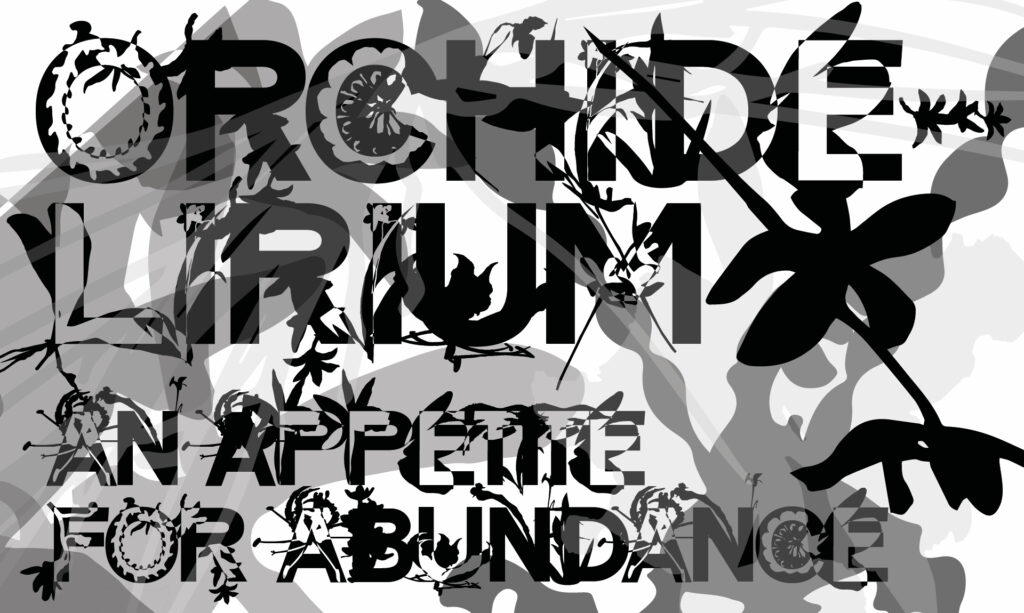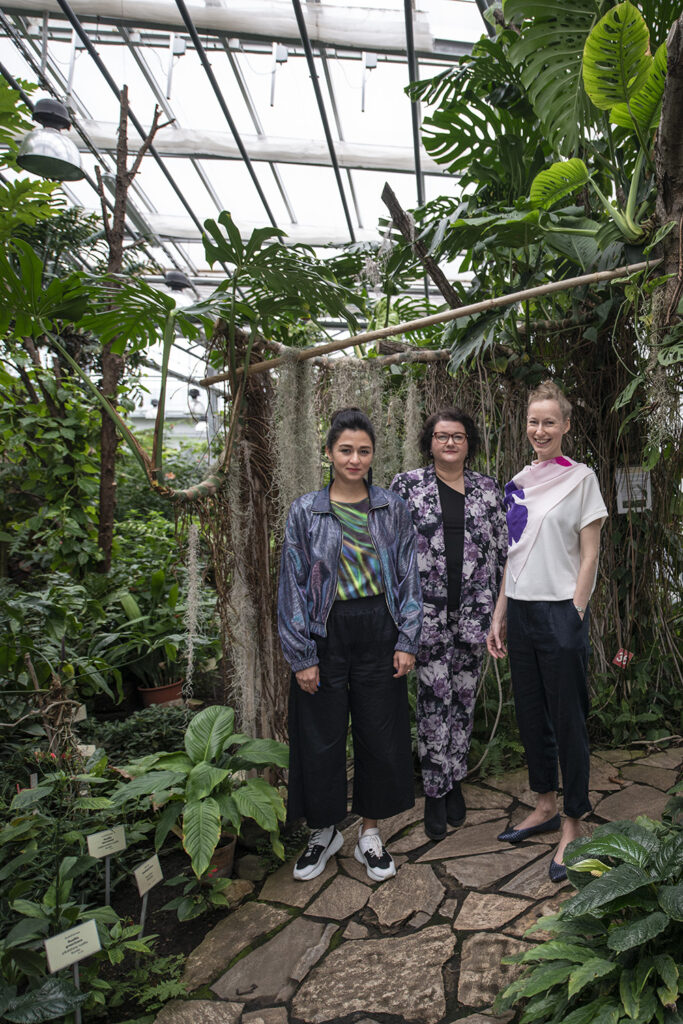
Estonian Pavilion at the 59th International Art Exhibition – La Biennale di Venezia
Title: Orchidelirium. An Appetite for Abundance
Participants: Kristina Norman and Bita Razavi
Based on the life and works of Emilie Rosalie Saal
Curator: Corina L. Apostol, Tallinn Art Hall (TAH)
Commissioner: Maria Arusoo, Estonian Centre for Contemporary Art (CCA)
23 April – 27 November 2022
Opening: 20 April 2022
Pre-opening: 20 – 22 April 2022
Giardini della Biennale, Rietveld Pavilion
estonianpavilion.virtualexhibition.eu
Link to the catalogue pdf (254,2 MB)
Link to the catalogue pdf (18,8 MB)

Kristina Norman and Bita Razavi, in close dialogue with curator Corina L. Apostol, will present “Orchidelirium. An Appetite for Abundance”, an exhibition encompassing installation, film, photography, archive and performance—connecting the past with the present, all through the lens of colonial botany and its socio-political ramifications. The artists and curator, with the guidance of advisor Sadiah Boonstra, and the contributions of a team of creative collaborators will create an immersive environment, featuring a film trilogy by Norman and a performative spatial intervention by Razavi.
The exhibition takes as its point of departure the overlooked story of the Estonian nineteenth-century artist and world traveler Emilie Rosalie Saal. Her work as an artist of tropical botanical flora combined with her personal history serves as a case study for entangled histories of self-determination, colonial experiences, neo-colonial structures, botany, science and art. The title of the project reflects the orchid madness that gripped Europeans in the nineteenth century, Saal included, fed by an abundance of botanical illustrations that erased contexts and promoted an extractivist vision of local landscapes and people. The obsession with collecting tropical orchids that spans histories and geographies inspired Apostol to research its symbolism as well as the abuse of power exercised by orchid adorers. What were the consequences of Saal’s choices for indigenous peoples and landscapes? Norman and Razavi reflect on their own cultural heritage and lived experiences, while trying to engage critically with the colonial and neo-colonial discourses in the context of Estonia today.
Norman’s films, entitled “Rip-off,” “Shelter” and “Thirst,” respectively, will explore the manor as an elite place of cultural transfer between upper-class Baltic German women and their servants through the knowledge of and fascination with tropical flowers; the cage as a liminal place of transformation, divided between a perspective from the inside and the objectifying gaze from the outside; the orchid nursery as a site connecting the Estonian mires and peat excavation industries, the import of tropical orchids and the circulation of capital and natural resources.
Razavi’s spatial intervention begins outside the pavilion, where the audience—initially unaware—enters into a system of categorisation. Re-enacting class divisions inscribed in architecture, she engages the viewer to reflect on the notions of hierarchy and privilege through performance. Addressing historical erasures and incomplete narratives, Razavi utilises changes of light in a site-specific installation and in display cases. A kinetic sculpture invokes a kratt, an enslaved magical creature from Estonian mythology, producing botanical drawings on command for those who accept its consequences.
Additionally, the viewer will discover Apostol’s research behind the project, in collaboration with Boonstra and the artists, which combines material from different archives in Estonia, the Netherlands and Indonesia and highlights positions of the colonial past and present. In collaboration with Norman and Apostol, choreographer and dancer Eko Supriyanto will develop a film-intervention that also asks: to what extent has coloniality actually ended? He explores the extensions of coloniality in nature, highlighting its ongoing exploitation in Indonesia and tying in issues of gender and race.
“Orchidelirium” examines the historical experience of serfdom in Estonia from which the Saal emerged, her role in Dutch colonial history, and the experiences of the colonised people of Indonesia—in tandem with the alteration of their indigenous landscapes during the late colonial period and the ecological impact it continues to have to this day. Immersed in the exhibition, the viewer will access de-colonial ecological imaginaries and the socio-political ramifications of colonial ways of being, thinking, misunderstanding and doing.
Participating since 1997, this is the thirteenth time Estonia is exhibiting at the International Art Exhibition of La Biennale di Venezia. The Estonian Centre for Contemporary Art is the official representative of the Estonian exposition and it is financed by Estonian Ministry of Culture.

Kristina Norman (1979) is a Tallinn based artist and documentary maker, explores the converging trajectories of national identity, politics of memory and public space. Norman’s most recent work is a poetical documentary performance entitled “Lighter Than Woman”, whose protagonists are Eastern European women who work in Italy as elderly care workers and who overcome the Gravity of life in a metaphorical and literal sense. This is Norman’s second time to present her work at the Venice Biennale – in 2009 she represented Estonia with her solo project “After-War“.
Bita Razavi (1983) is a multidisciplinary artist best known for her autofictional practice centered around observations and reflections on a variety of everyday situations. While working as a cleaner in Helsinki, Razavi photographed traces of design in Finnish homes observing them as manifestations of national identity (2010). She married her schoolmate in her studio at the Finnish Academy of Fine Arts to address Finnish immigration policies (2011) and spent four years renovating two houses in Estonia to study Soviet renovation materials throughout years of changing economic and political situations (2019). Razavi has exhibited in Biennials, won prizes and has her works in museum collections among all other achievements that are expected from any accomplished artist.
About Emilie Rosalie Saal
Emilie Rosalie Saal (1871–1954) was born in Tartu (then part of the Russian Empire), studied art in Petrograd (St. Petersburg), then joined Andes Saal in Java between 1899 and 1920. In many ways her story is similar to that of other European noblewomen who pursued botanical art as a pastime and occupation. At the same time, her accomplishments were particularly significant because, unlike many of her upper-class counterparts, she was able to continue to pursue art by traveling to Indonesia. Saal challenged convention by arranging trips on the islands to study tropical plants while becoming impressively proficient in drawing the fine details of local plants at the Buitenzorg Botanical Gardens. In 1926, after emigrating with her family to the United States, her collection of over 300 works was exhibited at the Los Angeles County Museum of Science and Art and widely praised by the press of the time.
About Corina L. Apostol
Corina L. Apostol (1984) is a curator at the Tallinn Art Hall and the co-curator and coordinator of the international collaborative, practice-based research project, “Beyond Matter – Cultural Heritage on the Verge of Virtual Reality”. Recently, she curated the Shelter Festival: “Cosmopolitics, Comradeship, and the Commons,” at the Space for Free Arts/ University of the Arts Helsinki (2019). Previously, she was the Andrew W. Mellon Fellow at Creative Time, where she co-edited the publication Making Another World Possible: 10 Creative Time Summits, 10 Global Issues, 100 Art Projects (2019). She has been longlisted for the Kandinsky Prize (2016) and the Sergey Kuryokhin Prize (2020).
About Estonian Centre for Contemporary Art (CCA)
Estonian Centre for Contemporary Art (CCA) is the oldest centre of expertise for contemporary art in Estonia. Creating opportunities and collaborations for Estonian artists and the Estonian art scene since 1992, CCA is also the commissioning organisation of the Estonian pavilion at the Venice Biennale since 1999. CCA is one of the main facilitators of international collaborations in the Estonian art scene through connecting artists, curators, critics and institutions. CCA also curates and organises exhibitions and other art events and publishes Estonian art news for our international network. CCA is a non-profit non-governmental organisation that is mostly supported by public resources. The main funder of CCA is the Estonian Ministry of Culture.
Press information
For information about CCA and the Estonian entry for 2022, please contact: head of communication of the Estonian Pavilion, Kaarin Kivirähk: kaarin@cca.ee / +372 5394 7169 or international PR-advisor Alexia Menikou: am@alexiamenikou.com / +44 (0) 7958 454 111
Team
Graphic Designer: Laura Pappa
Architects: Aet Ader and Arvi Anderson, b210
Technical Director: Tõnu Narro with a team of Mihkel Lember, Villem Säre, Aleksander Meresaar, Erik Liiv
Head of production: Sten Ojavee, CCA
Head of Communication: Kaarin Kivirähk, CCA
International PR Advisor: Alexia Menikou
Creative collaborators and advisors to the project: Kristaps Ancāns, Sadiah Boonstra, Linda Kaljundi, Maija Karhunen, David Kozma, Saku Kämäräinen and Pietu Pietiäinen (Post Theatre Collective), Märt-Matis Lill, Àngels Miralda, Meelis Muhu, Mari Mägi, Behzad Khosravi Noori, Erik Norkroos (Rühm Pluss Null), Tammo Sumera, Iris Oja, Cärol Ott, Tuuliki Peil, Ulrike Plath, Karolin Poska, Teresa Silva, Eko Supriyanto
Exhibition assistant: Simona Šulnytė
Orchid typeface: Jungmyung Lee & Laura Pappa
Website programming: Eva Rank
Commissioned and produced by Estonian Centre for Contemporary Art
Co-Producers: Tallinn Art Hall (Paul Aguraiuja), Rühm Pluss Null, Post Theatre Collective
Financed by the Estonian Ministry of Culture
With the support of Cobalt Law Firm, Estonian Cultural Endowment, Estonian Film Institute, Kone Foundation, HIAP, Frame Contemporary Art Finland, Arts Promotion Centre of Finland, City of Helsinki , Estonian Artists Association, Estonian Academy of Arts, Pallas Art School, DSV Transport and Logistics, Punch Drinks, Lincona, Temat Eesti OÜ, Metroprint